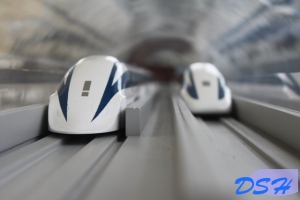Blog Archives
Japanese Linear Motor Car (Maglev) in Yamanashi
High speed rail transportation has been a national level key technology in Japan since the end of the WWII. As a result of continuous R&D efforts, the Japanese could unveil a precursor to the modern Shinkansen (Bullet Train) in 1957. This predecessor of the Shinkansen was called the “Romance Car 3000 Series SE” which was operated by the Odakyu Electric Railway. In 1957, it could break the world speed record by clocking speeds over 145 km/h. Encouraged by this achievement, Japanese researchers worked on the first generation bullet train technology and introduced the Shinkansen “0 Series” in 1963. Since then, the high speed rail technology has come a long way to the stage where trains can actually fly as in the case of the the linear motor car. Such large scale technological projects almost always get the green light from the Japanese public and political institutions unlike in many other countries. Investment in R&D is never considered an extra burden on the economy here!
Couple of days ago I stumbled upon some almost two-year old photographs from my visit to the Yamanashi Maglev test track. I remember after posting few of those pictures in facebook more than one year ago, I received many comments, views and questions from friends about the maglev and the underlying technology. So, I thought I should post some of those pictures here for the benefit of a wider audience. I do not intend to go into much detail about the underlying technology and comparisons with conventional rail here, which will be covered by a separate post later on.
First row Picture 4: Test track with embedded magnets; Third row picture 1: The dedicated power station for the maglev
Visitors to the test facility in Yamanashi not only can see the Maglev in action, but also the interested people can learn the basics of magnetic levitation and how it is used to operate the linear motor car. We were in luck because testing resumed on the exact day we went there after a six-month maintenance period. On some special days of the test calendar, visitors may also get the rare opportunity to ride the maglev from Tokyo to Kofu and back free of charge! While we were there, we saw the train clocking speeds over 580 km/h with extremely low level of noise. Since the train floats rather than dragging along a metal track, it makes an elastic sound. According to one research paper on the subject, the sound resembles that of drums used in an orchestra. The visible part of the test track is sandwiched between two tunnels approximately 2 km apart, compelling visitors to take pictures roughly within a 15 second window. A better vantage point for photographs is actually on the other side of the test track on a small hillock. The photographs reminded me how exciting it was to see the maglev flying at its maximum speed. It really takes your breath away!
Copyright (c) All Rights Reserved – dshwriter@suntomoon
You may contact the author at suntomoonblog@gmail.com








